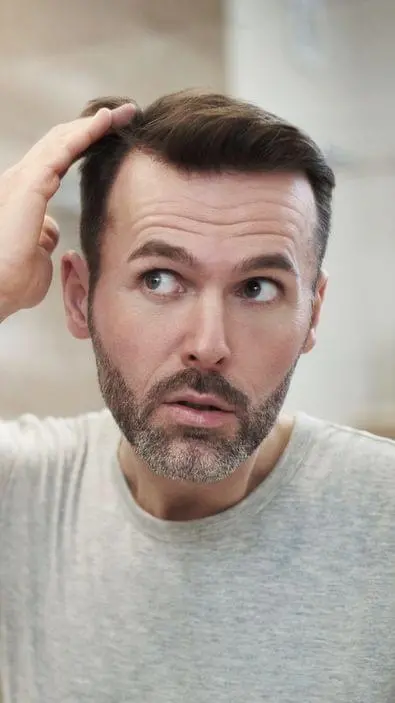
Hair Transplantation in Berlin
The hair falls out, a small bald patch forms at the back of the head, the forehead becomes higher and higher. There is no question about the fact that hair loss need not leave every head cold. For many men, hair transplantation has become a popular and accepted way to effectively combat premature hair loss. Although there are numerous drug therapies for hair loss, there are also many other ways to treat it. However, despite a large industrial sector specialising in such drugs and a number of naturopathic treatment options, there are still patients in whom any therapy is unsuccessful.
Hair Transplantation:
The Facts
Length of stay in the clinic
1 day outpatientAnesthesia
Local anaesthesiaFollow-up treatment
14 daysgentle treatment
Resumption of social activities
ImmediatelyPains
EasyDurability
ContinuousCost
from 2500.00 eurosWhen does a
hair transplant make sense?
- In men who have prematurely developed bald spots on their heads between the ages of 20 and 40
- For older men who suffer from age-related hair loss and want to feel younger again
- For patients with stress-related or disease-related hair loss

General Information about
Hair Transplantation
First you will learn how premature hair loss can occur. Afterwards the procedure of hair transplantation is explained and the different methods, FUE hair transplantation, transplantation of beard hair and eyebrow transplantation, are presented. We will describe our experiences, the results of our patients and the recommended behaviour after the procedure. Finally, we will discuss possible risks and the costs of a hair transplant in Berlin.
Hair Loss: What you need to know
There are numerous causes for hair loss: A genetic predisposition is often responsible for the fact that the growth phases of the hair follicles become shorter and shorter, especially in areas on the front of the head and on the crown of the hair. Unfortunately, men can already show large, bright spots on the head in their mid-20s to early 30s. This process sometimes continues until a semi bald patch is formed. This is often an especially big problem for young men, because their self-confidence suffers from it and they age prematurely. Stress can of course also be a trigger. According to studies, stress can change the hair cycle and thus promote hair loss.
Hair loss does not directly affect the health of the affected person, so that it is not recognized as a disease. Therefore, hair transplantation is an aesthetic operation that is not necessary from a purely medical point of view. Because of this, neither the statutory nor the private health insurance companies usually cover the costs of such a treatment.
However, exceptions can occasionally be made if the need for a hair transplantation has arisen as a result of an accident or a dermatological condition. Examples include accidental injuries, burns, skin diseases or severe alopecia-induced psychological stress.
Before the treatment, a consultation with your health insurance would be appropriate in case of doubt and could be worthwhile. Whether a private health insurance would cover the costs of a hair transplant in such a situation or would participate in it, you can probably find out from your insurance policy – although here too, contacting the health insurance can quickly provide clarity.
Generally speaking, women suffer from hair loss less frequently than men – due to hormonal hereditary predispositions, only one in ten women of childbearing age is affected by hair loss. During and after menopause, two to three out of ten female patients lose their hair, usually affecting the highly visible area of the middle parting, which often has an enormous impact on women’s self-esteem.Hair transplantation in a woman is considered one of the most demanding treatments in the field of hair transplantation. Nevertheless, this fact is often underestimated, with correspondingly worse treatment results, which causes an even higher loss of self-esteem of the affected female patients.
The reason for this are some peculiarities of the tissue of the women’s scalp in comparison to the men’s, which have to be taken into account. Women’s scalp is softer, finer and has a higher percentage of fat between the hair roots, so it can be easily injured and therefore must be treated very gently. In addition, the hair roots are finer and shorter and the hair shafts thinner and more fragile than in a man.
This requires, on the one hand, maximally gentle preparation techniques and, on the other hand, minimally traumatizing procedures when creating the transplantation channels in the scalp. These conditions require not only great skill and sensitivity, but also a great deal of experience in hair transplantation.
Hair loss in men is caused by somewhat different factors and also proceeds somewhat differently. On the one hand, it is usually hormonal-genetic – the so-called androgenic alopecia – and on the other hand, men in almost all age groups are affected. The death of the hair roots already begins at a young age between 20 and 25 years, and about eight out of ten men are affected. Initially, hair falls out on the temples as well as the forehead, so that over time a single strip of hair remains on the sides and back of the head, or eventually a large bald spot forms.
Hair loss is also very frustrating for men, as it is considered a sign of premature aging and leads to the dwindling of self-confidence. However, in contrast to women, men are much less likely to develop mental illnesses due to the psychological stress caused by hair loss.Hair transplantation for men is an effective and meanwhile proven method to compensate for male hair loss in the long term. In most cases, hair is transplanted from the back or side areas to the hairless areas of the head, as this hair grows permanently due to genetic predisposition and is less susceptible to the death of hair roots.
Hair Transplantation: Procedure and methods
The hair transplantation is performed under local anaesthesia and is therefore completely painless. Thanks to modern anaesthetics, only certain areas of the scalp need to be anaesthetised. The affected areas are cooled first, to ensure that patients do not feel any pain when the anaesthetic is injected. Platelet-rich plasma (PRP) can also be injected in the form of a syringe. The platelet-rich blood plasma obtained from the patient’s own blood significantly accelerates and improves hair growth by increasing the blood supply in the treatment area, so that the hair follicle environment is regenerated.
Cell growth can therefore be increased, wound healing is accelerated and correspondingly faster hair growth is promoted after the procedure. Depending on the individual wishes and findings of the patient, different methods can be used for hair transplantation:
FUE and FUT are hair transplantation methods that are mainly differentiated by the different hair follicle harvesting procedures. However, the actual transplantation (the hair transplantation) is performed in the same way in both cases. Neither of the two methods is the better solution, as it depends on the individual person which method is more suitable.
In Follicular Unit Extraction, the hair follicle is extracted one by one. This method is used when smooth, strong hair is involved and the hair transplantation is less extensive (less than 1000 grafts). The FUE method is particularly suitable for thickening the thinning hairlines, concealing scars and eliminating the corners of the receding hairline. It is also frequently used for thickening eyebrows and men’s beards. The advantage here, in contrast to the FUT technique, is the fact that the donor area remains largely scar-free.
Advantages
- Follicle harvesting from other parts of the body possible
- Point-like, almost invisible scars
- Rapid wound healing
Disadvantages
- Unsuitable for long hair
- Hair shaving required
- Costly and time-consuming
Follicular Unit Transplantation is considered the gold standard of hair transplantation, as this procedure is the most commonly used worldwide. Unlike the FUE technique, the hair roots are not taken individually, but on a strip of skin tissue from the back of the head. Both the large quantities of grafts and the very high growth rates make the FUT method extremely popular. Also extremely advantageous is the aspect that, with the help of the FUT technique, large-area hair transplants of up to 3000 units are possible in a shorter time.
Advantages
- Suitable for long hair
- High number of grafts per session
- Only the strip is shaved
- Inexpensive and fast
Disadvantages
- Larger scars on the donor area
- Longer convalescence
- Follicle removal only possible from the scalp
The so-called body hair transplantation (BHT) or body hair transplantation is a somewhat different type of own hair transplantation, which finds its use in case of a very extensive hair loss – if the donor hair in the area of the lateral and posterior scalp is not sufficient for a sufficient hair transplantation, body hair can be taken by means of the FUE technique from the abdominal and chest area, back, arms or legs and even beard hair can be transplanted into the recipient area. When body hair is transplanted into the scalp, it changes or adapts to the scalp hair to a certain extent – but not completely.
On the head, they grow somewhat faster and can also become longer than on the body. Nevertheless, the growth of transplanted body hair is somewhat limited, so they never reach the final length of head hair. Due to this, the final result of body hair transplants shows up a little later than conventional transplants of head hair.
Beard transplantation is a special form of hair transplantation. With a facial hair transplantation it is possible to replace missing facial hairs, to compress the beard and to fill gaps naturally.
The causes of eyebrow hair loss can be different. In many cases, however, there is a loss due to plucking of the eyebrow hairs, which is why it is primarily a female phenomenon. In these cases, eyebrow transplantation offers a good opportunity to restore natural eyebrow hair growth.
Experiences / Results After the Operation
As a rule, our patients notice a visible and permanently satisfactory result after about 12 months after the operation. The speed of hair growth and the abundance of regrowing hair varies from patient to patient. In general, however, it can be said that the first growth phase after the hair transplantation starts about three to five months after the hair transplantation. New hair or hair follicles are formed.
During this development phase, minimal unevenness may occur, as the new hair shaft is pushed through the skin during this growth phase. Step by step the treated area fills up with strong new hair six to ten months after the hair transplantation. About eleven months after the procedure, positive changes can be observed. The final result can be seen in the twelfth month after the operation.
Although the surgical procedure for hair transplantation is long and can take several hours depending on the extent and number of grafts transplanted, it is extremely low-risk due to the gentle method of execution. Nevertheless, even with this procedure, the specific instructions of the treating doctor must be followed after the hair transplantation. This applies in particular to the taking of prescribed medication, but also the use of hair shampoos and care ointments. In principle, the recovery time after a hair transplant is minimal and manageable.
After the procedure, patients can return to work one or two days later. It is especially important to note that for the first ten days after the hair transplantation, one should avoid a major increase in blood pressure in the head, for example due to sports, physical work or stress. Direct contact with the head should also be avoided so that the transplanted follicles can grow into the scalp undisturbed. After the hair transplantation operation, scabs could develop on the affected area, but these should have completely receded after about twelve days. The same applies to redness and swelling after hair transplantation. These are possible in the first two weeks, but usually reside quickly.
Although you are almost immediately socially fit after a hair transplant, you should plan for a rest period of three or more days – naturally in accordance with your personal perception or sensation. In addition, it is advisable to wear a light head covering as a visual protection during the first ten days, as slight incrustations may form after the hair root transplantation. However, these will gradually dissolve within the first ten to twelve days during gentle hair washing, which is undoubtedly necessary. In addition, slight swelling and pain may occur, but experience has shown that this will quickly subside.
If you have received a transplant using the FUT method, you should refrain from heavy physical exertion for the first two weeks after the treatment, so that the sutures are not stressed. It would also be advisable to suspend your less strenuous, sporting activities during the first, post-operative week as well. In this way, the regeneration of the injured skin areas can take place more quickly. In the second week, you can slowly increase the intensity of exercise until you have reached your usual workload by the end of the second week. Furthermore, you should refrain from sauna, swimming, solarium as well as direct sunlight for at least three weeks after hair transplantation.
The FUT method requires a thread pull after two to three weeks, if no self-dissolving threads were processed, which do not need to be pulled out. With the FUE technique, this step is not necessary, as no stitching is required. Despite careful aftercare, more than 90 percent of the transplanted hairs will fall out within the first month after transplantation as a result of the surgical trauma. However, this is no cause for alarm, as the hair follicles remain in the scalp, so that the basis for hair growth is maintained and you can examine the final result after ten to twelve months.
Risks of hair transplantation in Sinis Clinic Berlin
Hair transplantation is more than 95% successful. This also means that patients need not worry about hair loss after hair transplantation. Because transplanted hair does not fall out. The reason for this is simple. Since the transplanted hair, including the root, is taken from an area not affected by hair loss, the transplanted hair is not affected by genetic hair loss. After growing into the scalp and calming the operated area, the ‘new’ hairs will therefore not fall out, as they have less or no tendency to fall out due to their DNA in the hair root.
In the case of hair transplantation, it is important to make sure that the surgeon performing the procedure has the appropriate special training and sufficient experience. From a medical point of view, no major risks are to be expected with a hair transplant, especially since the procedure is usually performed under local anesthesia or in a so-called twilight sleep.
This means the transplantation of your own hair is time-consuming, but rather harmless and can even be carried out on an outpatient basis. However, as with any surgical procedure, minor complications, side effects and risks may occur, depending on the individual characteristics of the patient. For example, if you have an intolerance or allergy to painkillers, it is essential that this is stated in advance. In addition, the long time spent sitting or lying can lead to increased stress on the cardiovascular system.
Costs of hair transplantation in Berlin
At the Sinis Clinic Berlin, each of our patients is treated individually. This is because it is important to pay attention to the individual needs of each patient in order to ensure optimal treatment, especially with a sensitive subject like hair transplantation. Therefore, we do not offer all-inclusive prices. Instead, the costs can vary depending on personal needs. Costs for a hair transplant can be precisely determined in an individual consultation. The costs for a hair transplant are calculated according to the number of grafts (hair follicles) transplanted plus material. The costs for the first consultation are generally based on the scale of fees for doctors. Thereafter, patients pay 90 € for the initial consultation with anamnesis, collection of previous findings, physical examination and preparation of a therapy and cost plan. This fee is payable once and will not be credited towards further treatment.
We would also be happy to advise you comprehensively on your hair transplant in Berlin – please fill out the following contact form or make an appointment for advice at:
030 – 22 38 99 08
The cost breakdown for a hair transplantation depends exclusively on the individual case. The pricing is mainly based on the expense of the treatment, whereby the focus here is on the one hand the suitable method and on the other hand the quantity of the transplants (grafts). The grafting of a full bald head will of course generate higher costs than the thickening of light receding hairline. Because of this, no binding, blanket statements can be made in this regard. Therefore, before a hair transplantation, a detailed consultation is essential, in the course of which both the necessary examinations are carried out and the costs are determined.
The price range for a hair transplant is very broad – starting at around 2000 euros, the costs can rise to 8000 euros and more, depending on the area of the bald spots. Therefore, a complex transplantation, which requires several sessions lasting several hours, can possibly generate costs in the five-digit range in individual cases. Unfortunately, we cannot give an exact sum as a lump sum, since the circumstances vary for each individual procedure and for each patient.
Each hair transplant is individual and accordingly requires an individual cost breakdown. The total price of a hair transplant depends on the extent of the procedure as well as the number of hair follicles (grafts) implanted. In addition, qualified medical consultations, treatment and control appointments are included in the total price. Therefore, you can receive an exact cost breakdown only after a detailed consultation – after your hair situation has been assessed, your personal expectations have been clarified and the cost of the operation has been determined.
Consultation
Open continuously from Tuesday 08.00 to Saturday 14.00
Open continuously from Tuesday 08.00 to Saturday 14.00

Testimonials

